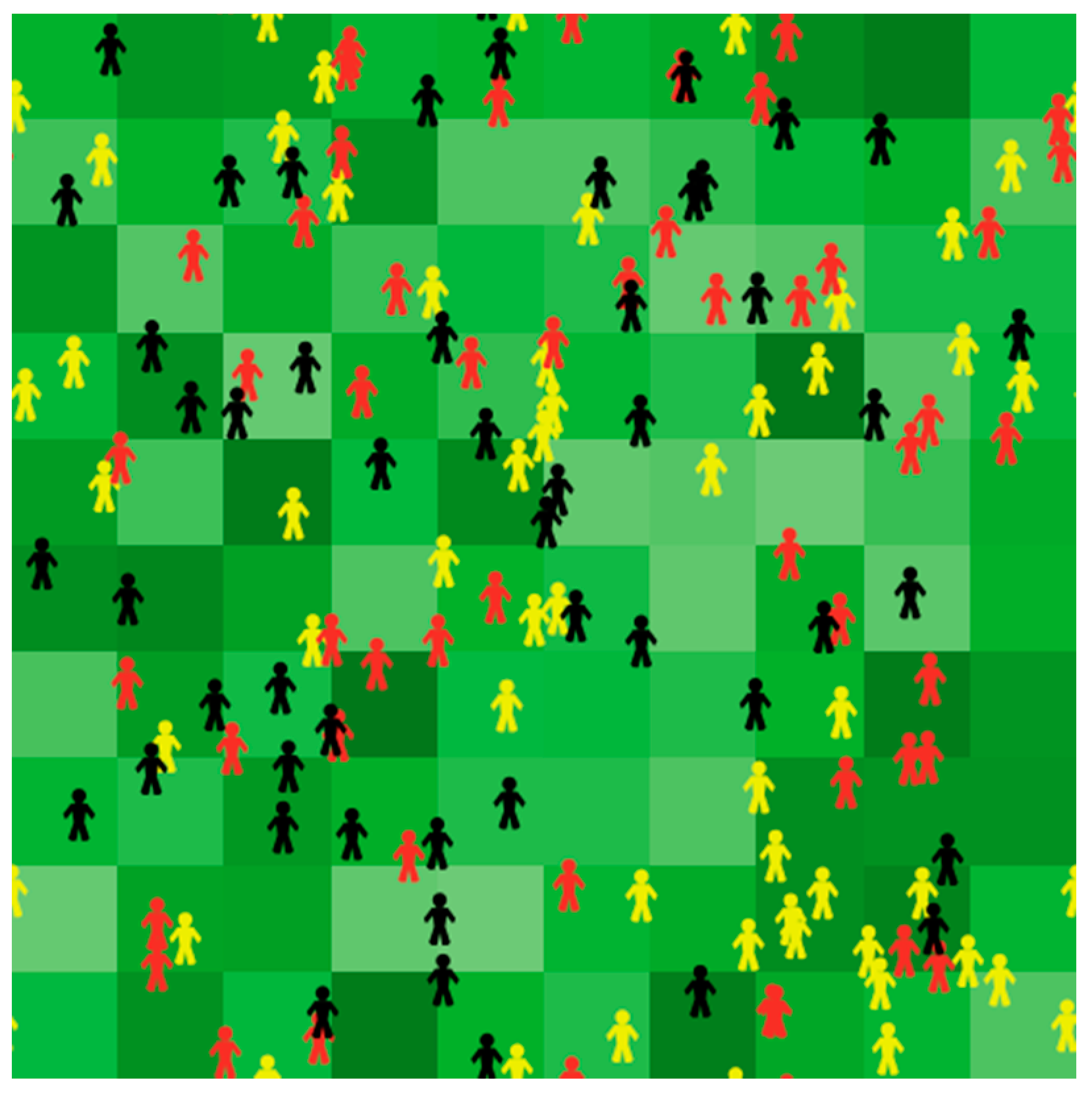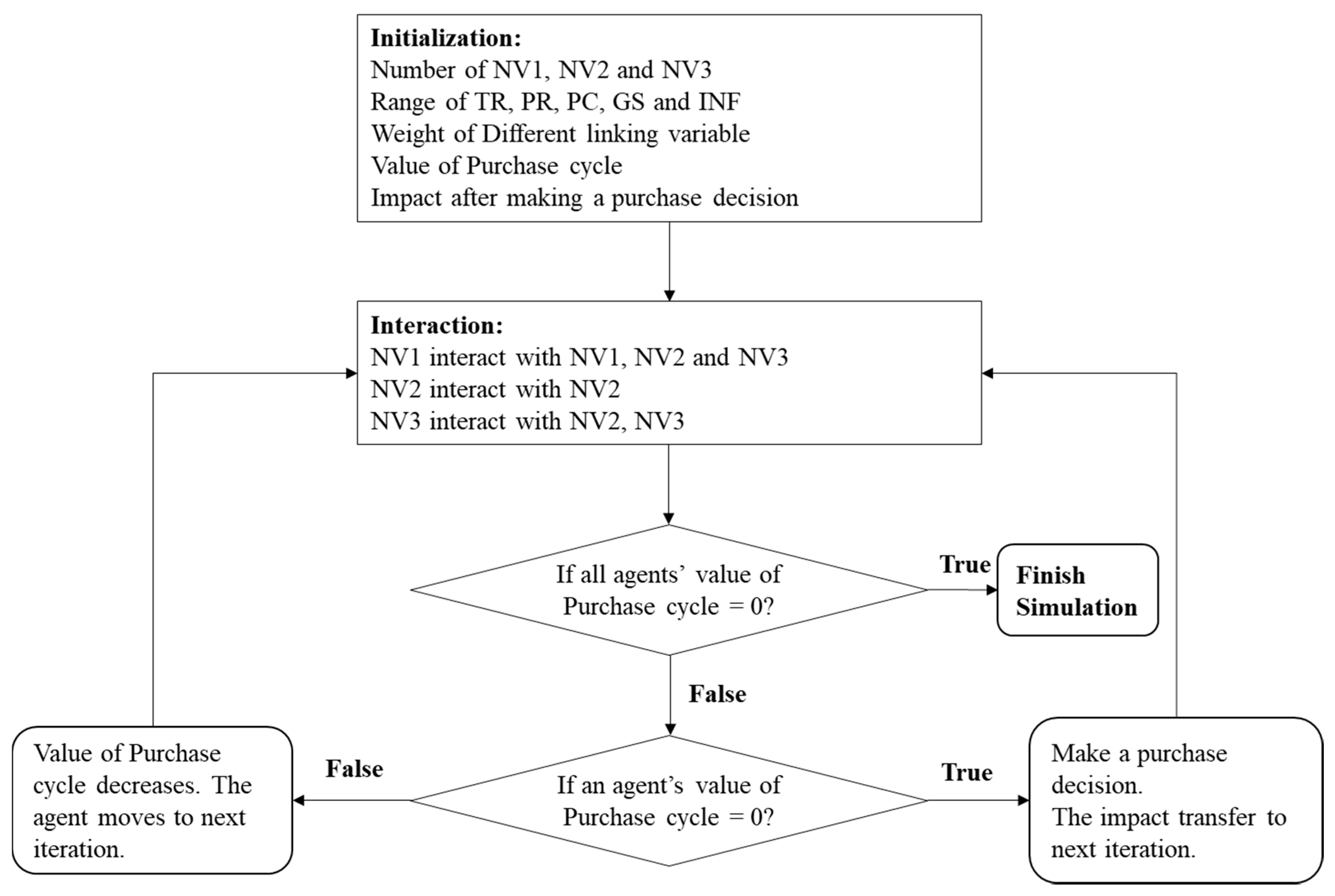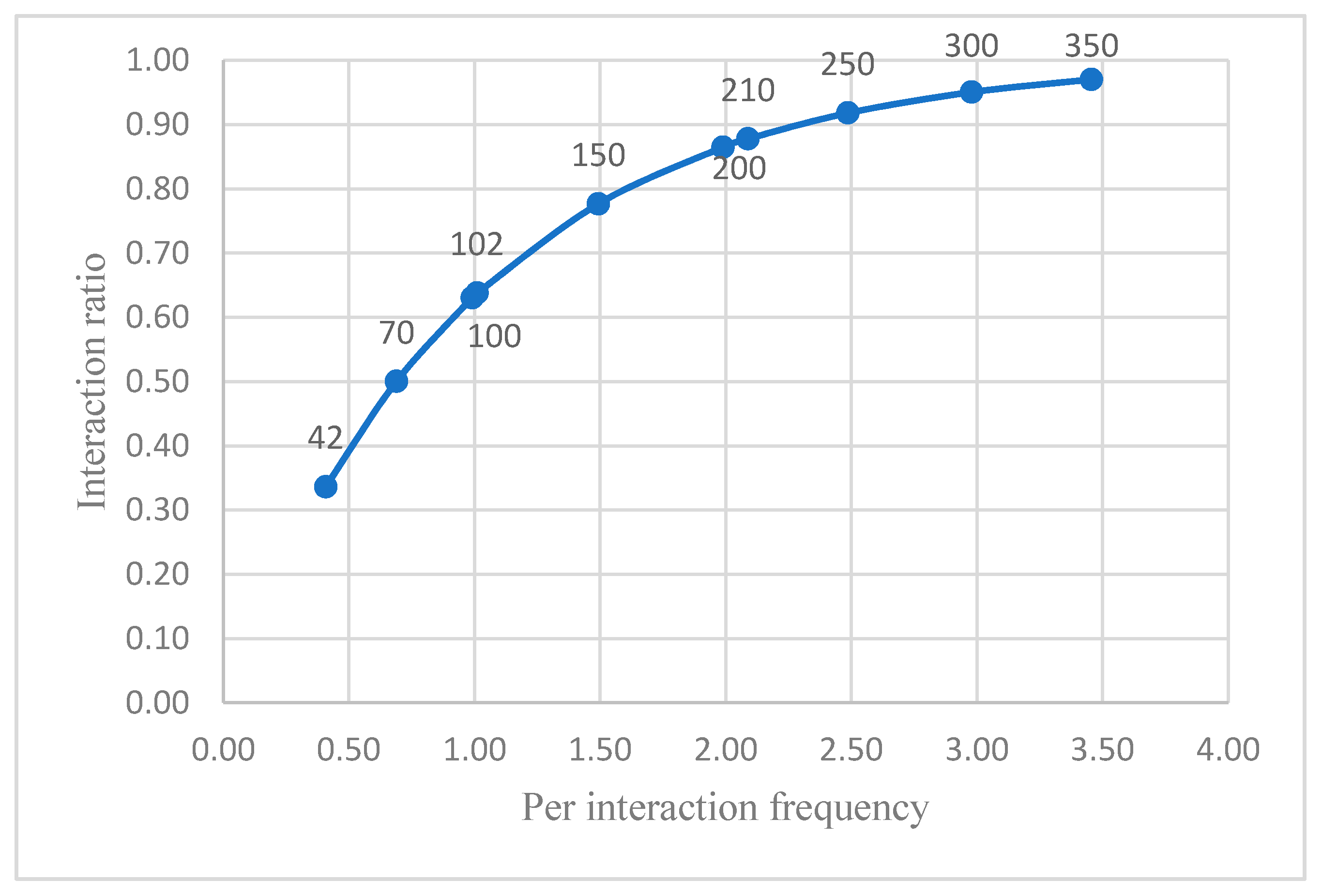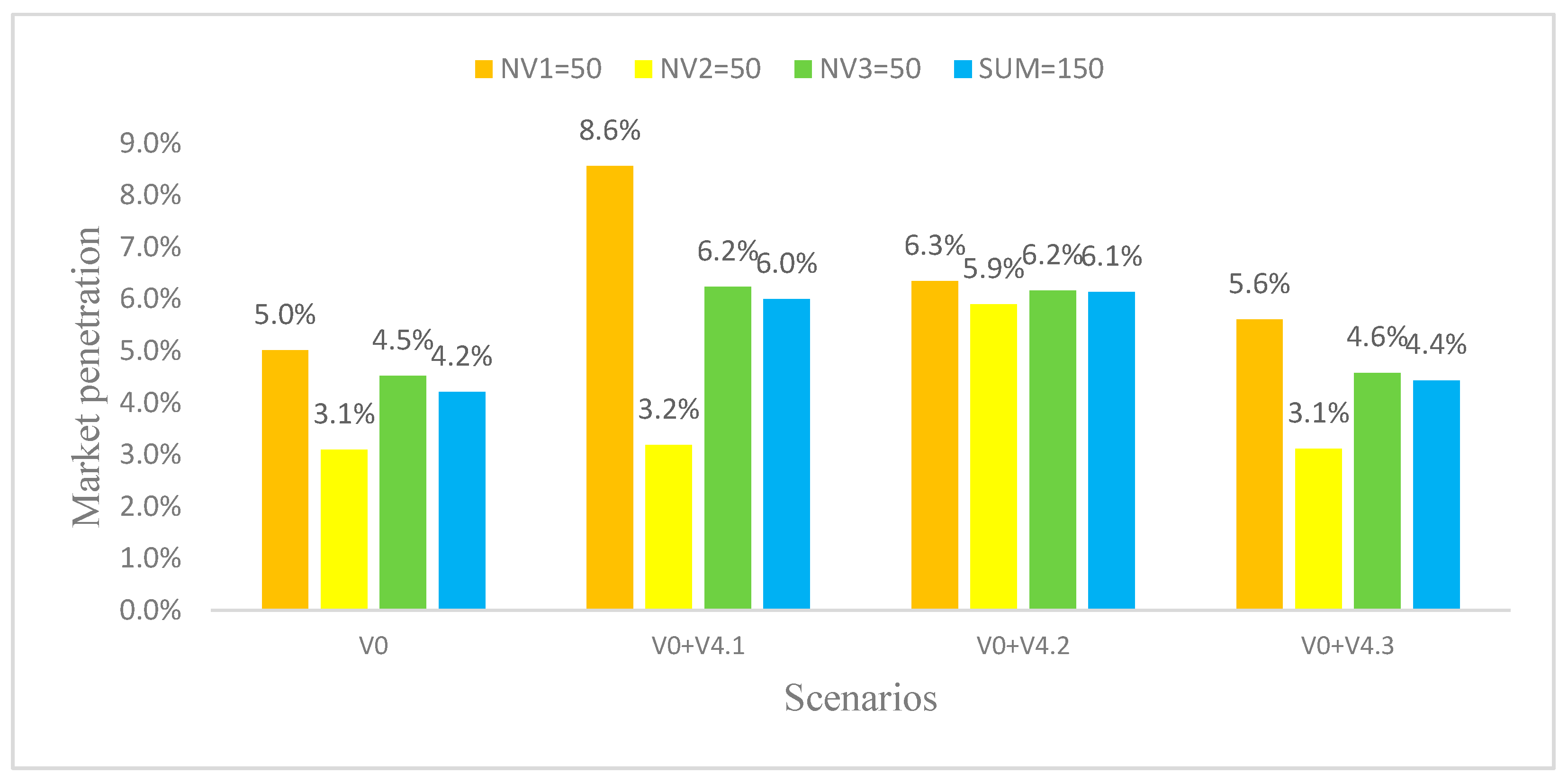How to Improve the Market Penetration of New Energy Vehicles in China: An Agent-Based Model with a Three-Level Variables Structure
Abstract
:1. Introduction
2. Literature Review
2.1. Scope of the Study
2.2. Research Areas of ABM
2.2.1. Model Variable
2.2.2. Agent Types
2.2.3. Flow Chart
2.2.4. Mixed Models
3. Model Description
3.1. Agent Choice
3.2. Agent Variables
3.3. Interaction Rules
4. Case Study
4.1. The Number of Agents
4.2. Calibration and Verification
4.3. Results and Discussions
4.3.1. Sensitivity Analysis of V1 and V2
4.3.2. Sensitivity Analysis of V3
4.3.3. Sensitivity Analysis of V4
4.3.4. Sensitivity Analysis of V5
4.4. Establish the Relationship between Linking Variables and Micro Variables
5. Implications of Our Work
5.1. Theoretical Implication
- (1)
- This paper develops an agent-based model with linking variables (ABML) to investigate the factors affecting the new energy vehicles market in China. The ABML is a general framework and provides causal insights among knowledge (micro variables), association (linking variables), and conception (macro variables).
- (2)
- The emergence from bottom to top occurs between the linking and macro variables, and the best–worst scaling describes the mapping between the micro and linking variables. This method can alleviate the overburden variables and the complexity of the simulation.
- (3)
- The agent choice description is newly developed. Rookie, Veteran, and New Generation consumers are suitable for China’s market. The categorization of agents is helpful for the interaction and can be applied to some similar research.
- (4)
- This paper creatively proposes an experimental method to determine the size of the behavior space and the number of agents, which has two evaluation dimensions, i.e., the per interaction frequency and the interaction ratio.
5.2. Managerial Implication
- (1)
- The low-level market share of NEVs will inhibit the accumulation of purchase intention and product competitiveness in NEVs. Market penetration is an important index for evaluating the development of NEVs.
- (2)
- Increasing the purchase attraction of NEVs or weakening the purchase anxiety of NEVs can narrow the difference between the increment in NEVP by purchasing NEVs and the decrement in NEVP by purchasing ICEs. The change will bring the market penetration of NEV a foreseeable increment.
- (3)
- Expanding the scope of consumers’ interaction can increase the total market penetration of NEVs, including browsing automobile websites and establishing Wechat groups. The open and innovative marketing model has been validated in Tesla.
- (4)
- It is more effective by investing and promoting NEVs in cities with high car ownership. The rapid development of NEVs in Beijing and Shanghai also confirms this point. These cities have more advantages for NEVs in traffic restriction, purchase restriction, government subsidy, and infrastructures.
- (5)
- In the technological dimension, NEVs are technology-intensive innovative products, while ICEs have been mature products for over 100 years. Considering the unbalanced distribution of charging infrastructures and low charging efficiency, it must rely on developing unique characters and usage scenarios to increase the market penetration of NEVs, and thus innovation is important for NEVs.
6. Conclusions
Author Contributions
Funding
Institutional Review Board Statement
Informed Consent Statement
Data Availability Statement
Acknowledgments
Conflicts of Interest
References
- Lim, W.M. Inside the sustainable consumption theoretical toolbox: Critical concepts for sustainability, consumption, and marketing. J. Bus. Res. 2017, 78, 69–80. [Google Scholar] [CrossRef]
- Ajanovic, A.; Haas, R. Dissemination of electric vehicles in urban areas: Major factors for success. Energy 2016, 115, 1451–1458. [Google Scholar] [CrossRef]
- Krause, R.M.; Lane, B.W.; Carley, S.; Graham, J.D. demand by urban consumers for plug-in electric vehicles under future cost and technological scenarios. Int. J. Sustain. Transp. 2016, 10, 742–751. [Google Scholar] [CrossRef]
- Lim, W.M. A blueprint for sustainability marketing: Defining its conceptual boundaries for progress. Mark. Theory 2016, 16, 232–249. [Google Scholar] [CrossRef]
- Melton, N.; Axsen, J.; Goldberg, S. Evaluating plug-in electric vehicle policies in the context of long-term greenhouse gas reduction goals: Comparing 10 Canadian provinces using the “PEV policy report card”. Energy Policy 2017, 107, 381–393. [Google Scholar] [CrossRef]
- Langbroek JH, M.; Franklin, J.P.; Susilo, Y.O. The effect of policy incentives on electric vehicle adoption. Energy Policy 2016, 94, 94–103. [Google Scholar] [CrossRef]
- Wang, L.; Fu, Z.L.; Guo, W.; Liang, R.Y.; Shao, H.Y. What influences sales market of new energy vehicles in China? Empirical study based on survey of consumers’ purchase reasons. Energy Policy 2020, 142, 111484. [Google Scholar] [CrossRef]
- Martinez, L.M.; Viegas, J.M. Assessing the impacts of deploying a shared self-driving urban mobility system: An agent-based model applied to the city of Lisbon, Portugal. Int. J. Transp. Sci. Technol. 2017, 6, 13–27. [Google Scholar] [CrossRef]
- Liu, D.; Xiao, B. Exploring the development of electric vehicles under policy incentives: A scenario-based system dynamics model. Energy Policy 2018, 120, 8–23. [Google Scholar] [CrossRef]
- Ma, S.C.; Fan, Y.; Feng, L. An evaluation of government incentives for new energy vehicles in China focusing on vehicle purchasing restrictions. Energy Policy 2017, 110, 609–618. [Google Scholar] [CrossRef]
- Abar, S.; Theodoropoulos, G.K.; Lemarinier, P.; O’Hare, G. Agent Based Modelling and Simulation tools: A review of the state-of-art software. Comput. Sci. Rev. 2017, 24, 13–33. [Google Scholar] [CrossRef]
- Al-Alawi, B.M.; Bradley, T.H. Review of hybrid, plug-in hybrid, and electric vehicle market modeling studies. Renew. Sustain. Energy Rev. 2013, 21, 190–203. [Google Scholar] [CrossRef]
- Sullivan, J.L.; Salmeen, I.; Simon, C. PHEV Marketplace Penetration: An Agent Based Simulation; University of Michigan, Ann Arbor, Transportation Research Institute: Ann Arborm, MI, USA, 2009. [Google Scholar]
- Cui, X.; Kim, H.K.; Liu, C.; Kao, S.C.; Bhaduri, B.L. Simulating the household plug-in hybrid electric vehicle distribution and its electric dis-tribution network impacts. Transp. Res. Part D-Transp. Environ. 2012, 17, 548–554. [Google Scholar] [CrossRef]
- Spangher, L.; Gorman, W.; Bauer, G.; Xu, Y.; Atkinson, C. Quantifying the impact of U.S. electric vehicle sales on light-duty vehicle fleet CO2 emissions using a novel agent-based simulation. Transp. Res. Part D-Transp. Environ. 2019, 72, 358–377. [Google Scholar] [CrossRef]
- Kangur, A.; Jager, W.; Verbrugge, R.; Bockarjova, M. An agent-based model for diffusion of electric vehicles. J. Environ. Psychol. 2017, 52, 166–182. [Google Scholar] [CrossRef] [Green Version]
- Eppstein, M.J.; Grover, D.K.; Marshall, J.S.; Rizzo, D.M. An agent-based model to study market penetration of plug-in hybrid elec-tric vehicles. Energy Policy 2011, 39, 3789–3802. [Google Scholar] [CrossRef]
- Shafiei, E.; Thorkelsson, H.; Ásgeirsson, E.I.; Davidsdottir, B.; Raberto, M.; Stefansson, H. An agent-based modeling approach to predict the evolution of market share of electric vehicles: A case study from Iceland. Technol. Forecast. Soc. Chang. 2012, 79, 1638–1653. [Google Scholar] [CrossRef]
- Wolinetz, M.; Axsen, J. How policy can build the plug-in electric vehicle market: Insights from the REspondent-based Preference and Constraints (REPAC) model. Technol. Forecast. Soc. Chang. 2017, 117, 238–250. [Google Scholar] [CrossRef]
- Silvia, C.; Krause, R.M. Assessing the impact of policy interventions on the adoption of plug-in electric vehicles: An agent-based model. Energy Policy 2016, 96, 105–118. [Google Scholar] [CrossRef]
- McCoy, D.; Lyons, S. Consumer preferences and the influence of networks in electric vehicle diffusion: An agent-based microsimulation in Ireland. Energy Res. Soc. Sci. 2014, 3, 89–101. [Google Scholar] [CrossRef]
- Noori, M.; Tatari, O. Development of an agent-based model for regional market penetration projections of electric vehicles in the United States. Energy 2016, 96, 215–230. [Google Scholar] [CrossRef]
- Hesselink, L.X.W.; Chappin, E.J.L. Adoption of energy efficient technologies by households—Barriers, policies and agent-based modelling studies. Renew. Sustain. Energy Rev. 2019, 99, 29–41. [Google Scholar] [CrossRef]
- Zhang, X.L.; Thorstensen, T. Experience Driven Change: Consumer Experience Management in Automobile Product Strategy; China Architecture & Building Press: Beijing, China, 2020. [Google Scholar]
- Kim, H.M.; Rideout, D.G.; Papalambros, P.Y.; Stein, J.L. Analytical target cascading in automotive vehicle design. J. Mech. Des. 2003, 125, 481–489. [Google Scholar] [CrossRef] [Green Version]
- Tyner, E.H.; Boyer, T.A. Applying best-worst scaling to rank ecosystem and economic benefits of restoration and conservation in the Great Lakes. J. Environ. Manag. 2020, 255, 109888. [Google Scholar] [CrossRef]
- Delre, S.A.; Jager, W.; Bijmolt, T.H.; Janssen, M.A. Will it spread or not? The effects of social influences and network topology on innovation diffusion. J. Prod. Innov. Manag. 2010, 27, 267–282. [Google Scholar] [CrossRef]
- Zhang, J.; Johnson, F.R.; Mohamed, A.F.; Hauber, A.B. Too many attributes: A test of the validity of combining discrete-choice and best–worst scaling data. J. Choice Model. 2015, 15, 1–13. [Google Scholar] [CrossRef]
- Cohen, E.; Goodman, S.; Cohen, E. Applying best-worst scaling to wine marketing. Int. J. Wine Bus. Res. 2009, 21, 8–23. [Google Scholar] [CrossRef]
- Antonini, G.; Bierlaire, M.; Weber, M. Discrete choice models of pedestrian walking behavior. Transp. Res. Part B Methodol. 2006, 40, 667–687. [Google Scholar] [CrossRef]
- Michalek, J.J.; Papalambros, P.Y. An efficient weighting update method to achieve acceptable consistency deviation in analytical target cascading. J. Mech. Des. 2005, 127, 206–214. [Google Scholar] [CrossRef] [Green Version]
- Galati, A.; Giacomarra, M.; Concialdi, P.; Crescimanno, M. Exploring the feasibility of introducing electric freight vehicles in the short food supply chain: A multi-stakeholder approach. Case Stud. Transp. Policy 2021, 9, 950–957. [Google Scholar] [CrossRef]
- Giacomarra, M.; Tulone, A.; Crescimanno, M.; Galati, A. Electric mobility in the Sicilian short food supply chain. Stud. Agric. Econ. 2019, 121, 84–93. [Google Scholar] [CrossRef]







| Variable Type | Variables | ||||
|---|---|---|---|---|---|
| Macro variables | Market penetration, NEV purchase index (NEVP) | ||||
| Linking variables | Traffic restriction index (TR) | Purchase restriction index (PR) | NEV Product competitiveness index (PC) | Government subsidy index (GS) | Infrastructure index (INF) |
| Micro variables | Traffic restriction time of ICE | The lottery probability for license plate of ICE | Battery warranty policy | Exempt tax of NEV | The compatibility of charging INF |
| Traffic restriction region of ICE | The lottery probability for license plate of HEV | Noise vibration and harshness of NEV | Country subsidy | The number of charging INF | |
| Traffic restriction time of HEV | The lottery probability for license plate of BEV and PHEV | Scrap value of NEV | Provincial subsidy | The distribution of charging INF | |
| Traffic restriction region of HEV | Purchase qualification of NEV | Battery range | Charging cost subsidy | The construction of fast charging INF | |
| Punishment standard for violating traffic restriction | List of NEV | Innovation of NEV | The installation qualification of personal charging INF | ||
| Traffic restriction policy for foreign license plate | Purchase qualification of ICE | ||||
| Line 1 | if NEVP > 100 [set NEVP 100] |
| Line 2 | if NEVP < 0 [set NEVP 0 ] |
| Line 3 | let n4 p × NEVP |
| Line 4 | let n5 random-float 100 |
| Line 5 | ifelse n4 >= n5 |
| Line 6 | [set Eamount Eamount + Evariation |
| Line 7 | set nev 1 |
| Line 8 | set ice 0 ] |
| Line 9 | [set Eamount Eamount—Evariation |
| Line 10 | set nev 0 |
| Line 11 | set ice 1 ] |
| Line 12 | set color grey |
| Eamount | the sum of impact on the current region |
| Evariation | a positive number |
| A | B0 | B1 | B1 | B1 | B1 | B1 | B1 | B1 | B1 | B1 | B1 | If | Ir | |
|---|---|---|---|---|---|---|---|---|---|---|---|---|---|---|
| 1 | 42 | 65.5 | 27.9 | 5.7 | 0.8 | 0.1 | 0.0 | 0.0 | 0.0 | 0.0 | 0.0 | 0.0 | 0.41 | 33.6% |
| 2 | 70 | 49.5 | 35.0 | 12.2 | 2.8 | 0.5 | 0.1 | 0.0 | 0.0 | 0.0 | 0.0 | 0.0 | 0.69 | 50.0% |
| 3 | 100 | 36.6 | 37.0 | 18.5 | 6.1 | 1.5 | 0.3 | 0.0 | 0.0 | 0.0 | 0.0 | 0.0 | 0.99 | 63.0% |
| 4 | 102 | 35.9 | 37.0 | 18.9 | 6.3 | 1.6 | 0.3 | 0.0 | 0.0 | 0.0 | 0.0 | 0.0 | 1.01 | 63.8% |
| 5 | 150 | 22.2 | 33.5 | 25.2 | 12.6 | 4.7 | 1.4 | 0.3 | 0.1 | 0.0 | 0.0 | 0.0 | 1.49 | 77.6% |
| 6 | 200 | 13.4 | 27.1 | 27.2 | 18.1 | 9.1 | 3.6 | 1.2 | 0.3 | 0.1 | 0.0 | 0.0 | 1.99 | 86.5% |
| 7 | 210 | 12.1 | 25.7 | 27.2 | 19.0 | 9.9 | 4.1 | 1.4 | 0.4 | 0.1 | 0.0 | 0.0 | 2.09 | 87.8% |
| 8 | 250 | 8.1 | 20.5 | 25.7 | 21.5 | 13.4 | 6.7 | 2.7 | 1.0 | 0.3 | 0.1 | 0.0 | 2.49 | 91.8% |
| 9 | 300 | 4.9 | 14.9 | 22.5 | 22.5 | 16.9 | 10.1 | 5.0 | 2.1 | 0.8 | 0.3 | 0.1 | 2.98 | 95.0% |
| 10 | 350 | 3.1 | 10.5 | 18.5 | 21.7 | 19.0 | 13.3 | 7.7 | 3.8 | 1.6 | 0.6 | 0.2 | 3.46 | 97.0% |
| 2017 | 2018 | 2019 | By July 2020 | |
|---|---|---|---|---|
| PHEV | 102,785 | 255,545 | 179,797 | 97,037 |
| BEV | 453,586 | 751,276 | 841,687 | 302,468 |
| HEV | 141,979 | 223,294 | 294,707 | 202,507 |
| ICE (only gasoline) | 22,750,748 | 20,882,013 | 18,609,620 | 8,293,515 |
| ICE (gasoline and HEV)/ NEV (PHEV and BEV) | 41.1 | 21.0 | 18.5 | 21.3 |
| NEV/(NEV + ICE) | 2.4% | 4.6% | 5.1% | 4.5% |
| Traffic Restriction Index (TR) | Purchase Restriction Index (PR) | NEV Product Competitiveness Index (PC) | Government Subsidy Index (GS) | Infrastructure Index (INF) | |
|---|---|---|---|---|---|
| NV1 | (60, 100) | (60, 100) | (0, 40) | (10, 90) | (40, 80) |
| NV2 | (10, 30) | (0, 20) | (40, 80) | (0, 60) | (0, 40) |
| NV3 | (30, 70) | (40, 80) | (20, 60) | (0, 80) | (20, 60) |
| Expected TR | Expected PR | Expected PC | Expected GS | Expected INF | Expected NEVP | |
|---|---|---|---|---|---|---|
| NV1 | 80 | 80 | 20 | 50 | 60 | 58 |
| NV2 | 20 | 10 | 60 | 30 | 20 | 28 |
| NV3 | 50 | 60 | 40 | 40 | 40 | 46 |
| p = 0.2 | No-Interaction Rules | Given Interaction Rules | ||
|---|---|---|---|---|
| Expected Number | Expected Market Penetration of NEV | Expected Number | Expected Market Penetration of NEV | |
| NV1 = 50 | 5.8 | 11.6% | 2.51 | 5.0% |
| NV2 = 50 | 2.8 | 5.6% | 1.55 | 3.1% |
| NV3 = 50 | 4.6 | 9.2% | 2.26 | 4.5% |
| SUM = 150 | 13.2 | 8.8% | 6.3 | 4.2% |
| Description | |
|---|---|
| Range of NEVP | (0, 100) |
| Interaction rules | NV1 interacts with NV1, NV2, and NV3 |
| NV2 interacts with NV2 | |
| NV3 interacts with NV2 and NV3 | |
| Purchase cycle minus 1 if the agent enters into the next loop | |
| Initialization | Eamount = 0; Evariation = 10; p = 0.2 |
| Uniform distribution in TR, PR, PC, GS and INF | |
| Purchase cycle is a random integer in [1, 6] | |
| Weight ci = ci/(c1 + c2 + c3 + c4 + c5), ci is a random integer in [1, 3], i = 1,2,3,4,5 | |
| NV1 = 50, NV2 = 50, and NV3 = 50 in 10×10 patches |
| Scenario | V0 | V0 + V4.1 | V0 + V4.2 | V0 + V4.3 |
|---|---|---|---|---|
| Interaction rules | NV1 interacts with NV1, NV2, and NV3 | NV1 interacts with NV1 | NV1 interacts with NV1, NV2, and NV3 | NV1 interacts with NV2 |
| NV2 interacts with NV2 | NV2 interacts with NV2 | NV2 interacts with NV1, NV2, and NV3 | NV2 interacts with NV2 | |
| NV3 interacts with NV2, NV3 | NV3 interacts with NV3 | NV3 interacts with NV1, NV2, and NV3 | NV3 interacts with NV2 |
| Choice Set Number | (6,5,2,2) | The Number of the Attribute | The Corresponding Description | ||
|---|---|---|---|---|---|
| (1) | 1 | 2 | 5 | 1 | The lottery probability for license plate of ICE |
| (2) | 1 | 2 | 6 | 2 | The lottery probability for license plate of HEV |
| (3) | 1 | 3 | 4 | 3 | The lottery probability for license plate of EV and PHEV |
| (4) | 1 | 3 | 6 | 4 | Purchase qualification of NEV |
| (5) | 1 | 4 | 5 | 5 | List of NEV |
| (6) | 2 | 3 | 4 | 6 | Purchase qualification of ICE |
| (7) | 2 | 3 | 5 | ||
| (8) | 2 | 4 | 6 | ||
| (9) | 3 | 5 | 6 | ||
| (10) | 4 | 5 | 6 | ||
| Remember the Purchase Restriction Index. For Each of the Following Tables, Tick the ONE Reason that MOST Influenced Your Choice and the ONE that LEAST | |||
|---|---|---|---|
| Least/Worst | Attribute | Most/Best | |
| □ | 1 | The lottery probability for license plate of ICE | □ |
| □ | 2 | The lottery probability for license plate of HEV | □ |
| □ | 3 | List of NEV | □ |
Publisher’s Note: MDPI stays neutral with regard to jurisdictional claims in published maps and institutional affiliations. |
© 2021 by the authors. Licensee MDPI, Basel, Switzerland. This article is an open access article distributed under the terms and conditions of the Creative Commons Attribution (CC BY) license (https://creativecommons.org/licenses/by/4.0/).
Share and Cite
Chen, M.; Liu, R.X.J.; Liu, C. How to Improve the Market Penetration of New Energy Vehicles in China: An Agent-Based Model with a Three-Level Variables Structure. Sustainability 2021, 13, 12307. https://doi.org/10.3390/su132112307
Chen M, Liu RXJ, Liu C. How to Improve the Market Penetration of New Energy Vehicles in China: An Agent-Based Model with a Three-Level Variables Structure. Sustainability. 2021; 13(21):12307. https://doi.org/10.3390/su132112307
Chicago/Turabian StyleChen, Mo, Rudy X. J. Liu, and Chaochao Liu. 2021. "How to Improve the Market Penetration of New Energy Vehicles in China: An Agent-Based Model with a Three-Level Variables Structure" Sustainability 13, no. 21: 12307. https://doi.org/10.3390/su132112307






